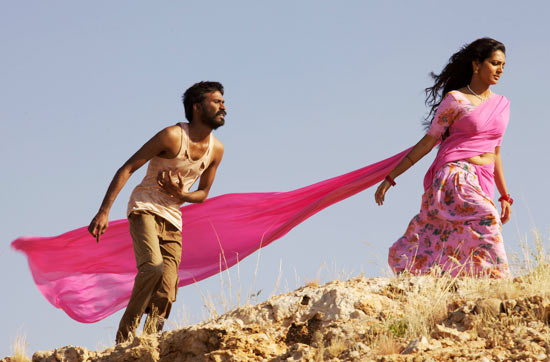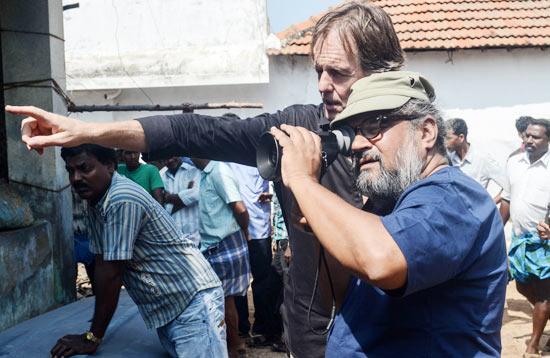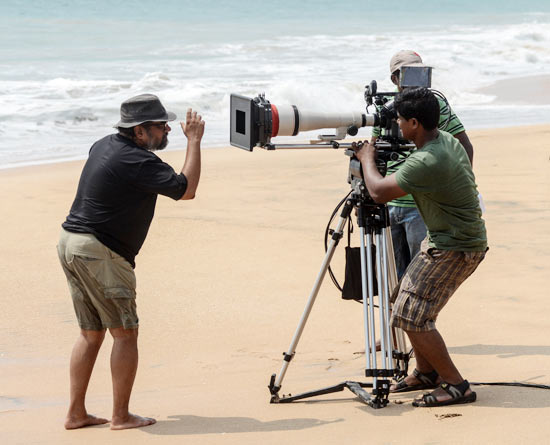
Bharat Bala's name is synonymous with Vande Mataram, the song and video with his friend A R Rahman. Equally popular was the Jana Gana Mana video. Bala had also directed the opening ceremony of the Commonwealth Games.
His first feature film, Hari Om, produced by Tips Films, was a success on the festival circuit. It premiered at the Toronto Film Festival and won eight audience awards at various festivals.
The shooting of his second film, Mariyaan, in Tamil, with Dhanush and Parvathi Menon (of Poo fame) is over, and Bharat Bala is back in Chennai.
In an exclusive chat with rediff, the director speaks about the unusual film he is making that will release this summer.
It was reported that you narrated the story of Mariyaan after the National awards ceremony in Delhi last year.
Yes. Six months before the awards ceremony, I had come across a news item about three immigrant workers from India being kidnapped in Sudan. Sudan is the largest oil producing country in Africa and a civil war is going on there.
They were working for ONGC there, and were captured by some child soldiers, who demanded a ransom. People of Sudan feel that their oil is being taken away. As always, nobody in India was bothered about the kidnap of its nationals, unlike say, America or Germany or the UK.
These three men somehow managed to escape. It's a story of human survival, and it fascinated me.

Did you meet the actual people and talk to them?
Yes, I did. What made them survive 21 days without food, water and shoes? Was it love for those who were waiting for them back home? The sheer will power to survive hit me.
Interestingly, one of the guys went back and joined the same company after six months as they were all from an economically poor background.
The story I wanted to show was how people work against all odds in risky places to survive in life. I thought it would be a good movie to make.
Did you think of Dhanush for the role after meeting him at the National awards ceremony, or did you gave him in mind when you decided on the story?
I was one of the jury members at the National awards committee that chose Dhanush as the best actor for Aadukalam. His performance in Aaduklaam moved me.
I was looking for a real person to carry this character. I needed to believe the character, his emotions and his journey. Who else but Dhanush could give me what I wanted?
After the awards, I congratulated him and later I told him the story. He liked the story in the first narration itself. I was halfway through the screenplay at that time. So, I went back and developed it some more.
He was so excited that he became part of the discussion for the next six months. Once I knew who was going to play the character, I fine-tuned the script to make it stronger.

Why did you decide to make the film in Tamil?
If you go to the southern part of Tamil Nadu, you will see that a lot of people from there go to the Middle East to work. Now, they go beyond the Middle East, to Africa.
The fishing community down south is going through terrible hardship but they are adventurous people. So, countries like Nigeria, Sudan, Libya etc take a lot of hard labour from south India.
I wanted a simple, economically poor but physically strong guy from a very remote village who was in need of a job. That was the fundamental story. He also has a life, a family, a love interest.
This film is about Mariyaan, the person.
What does 'Mariyaan' mean?
It is the name of the character. In Tamil it means a man who never dies. I want to say that the spirit of the man never dies. We researched a lot and came up with the name 'Mariyaan'.
How did you go about the shooting, as part of the story happens in an African country?
The story happens in Sudan. I had to find very rough terrain as half the film is set there. The next half is set in Kanyakumari. So, you can see two contrasting terrains in the film.
One half has aquamarine-blue oceans and that is where Kanyakumari comes in. The other half is sandy, rugged terrain. I chose Sudan as the place to shoot that part of the film.
I had seen a very compelling film called Johnny Mad Dog made by a French film maker. I loved the performance of the young kids from Liberia. They happened to be real-life child soldiers. The French film-maker had used real kids in his film, which interested me. So, I decided to use those kids and also use the same director of photography, Marc Koninckx, for my film. He is one of the most experienced and finest European cinematographers.
It was great making a Tamil film set in Sudan and filmed in Liberia with a French cameraman and Liberian actors, and the lead actress from Malayalam cinema. The only reason I had all these people is, because the story needs them.

How much is it the story of the child soldiers and how much about the plight of Mariyaan?
You will come to know all about the children through Mariyaan. You will get to know the political scenario too. It is not a one-sided story but fundamentally, it is Mariyaan's story and his survival.
What about the language when the story is set in Sudan? Will there be subtitles?
We will subtitle wherever necessary. Luckily, the African guys speak English. After a point, when there is aggression, you don't need dialogues.
You will see limited dialogues and more action. They talk in their own African language among themselves. Since I am seeing everything from Mariyaan's point of view, it is not necessary to subtitle those portions. Anyway, he doesn't understand what they say. I want the audience to travel with Mariyaan.
How was your experience dealing with the child soldiers?
It is very difficult for anyone to understand what went on in their lives and why they took to guns. There was this 16-year-old who was already a father of two children from two different women. It is very disturbing to see all this.
What scares you is that the moment they have the guns, they turn violent and they don't see any wrong in what they do. For them, a reason drives them to be violent and they don't see beyond that. It is very traumatic to watch these small kids hold a gun and use it.
I filmed for a month with them in Africa, and then they came here to do some close up shots.

How tough was filming in the African desert?
Not just shooting in the African desert, shooting the entire film was a challenging experience. You will not see a single bit of green in that part of the film.
You will be surprised but I shot the entire film in reverse. I started with the last scene and shot backwards.
Why?
It is because of the looks of Mariyaan that I shot that way. The guy is stuck somewhere in the desert and he is famished. I can't make him grow a beard as we shoot. So, we started from the struggle and then made him look clean.
So, the last scene of the film was my first shot! Usually the film grows in you and you arrive at the climax. Here, it was like unwinding.
I don't know why but while shooting the India part also, I shot backwards! Perhaps I got into the rhythm of going backwards.
It must have been really tough for Dhanush...
Yes, very tough. The kind of scenes he has done were very emotionally and physically draining. But, then, he is a professional.

Why did you choose Parvathi who is not a conventional heroine?
I was very particular that I wanted a good actress for the role of Panimalar. It is a very compelling role and emotionally challenging. I wanted someone who understands the language and feels what Panimalar goes through. I want audiences to believe the story, the characters and what they go through.
I had seen her film Poo and had liked her portrayal. She has not done many movies after that and that was an advantage for me.
You and A R Rahman have been working together for many years in advertisements and also in the highly successful Vande Maataram, Jana Gana Mana... etc. So, was it obvious that he would work in your first Tamil film also?
Yes, this is my first Tamil film and who else but Rahman to work with me in the film?
More importantly, it was not something taken for granted. For my first feature film Hari Om, Rahman didn't do the music.
When I narrated the story of Mariyaan, Rahman saw the promise. As a friend, he was a sounding board for me. He went through the entire process of how I evolved the story of Mariyaan. The spirit of human survival moved him. There was something fresh in the film for Rahman to work on.
You were supposed to make 19 Steps. What happened to the film?
Three years ago, I was supposed to make the first Indo-Japanese- Tamil film with the best actors from Japan and India. It was to be marketed internationally. Kamal Haasan and Asin were to act in the film. It was a martial arts story.
We had some difficulties 20 days before we were to start shooting. So I had to momentarily shelve the film. But the story is still exciting for me. Maybe after Mariyaan, I will look at it but with a fresh cast.
In Kalaripayattu, you have to take 18 steps to master the art and the 19th step is when you go beyond that, and that is realisation or moksha.